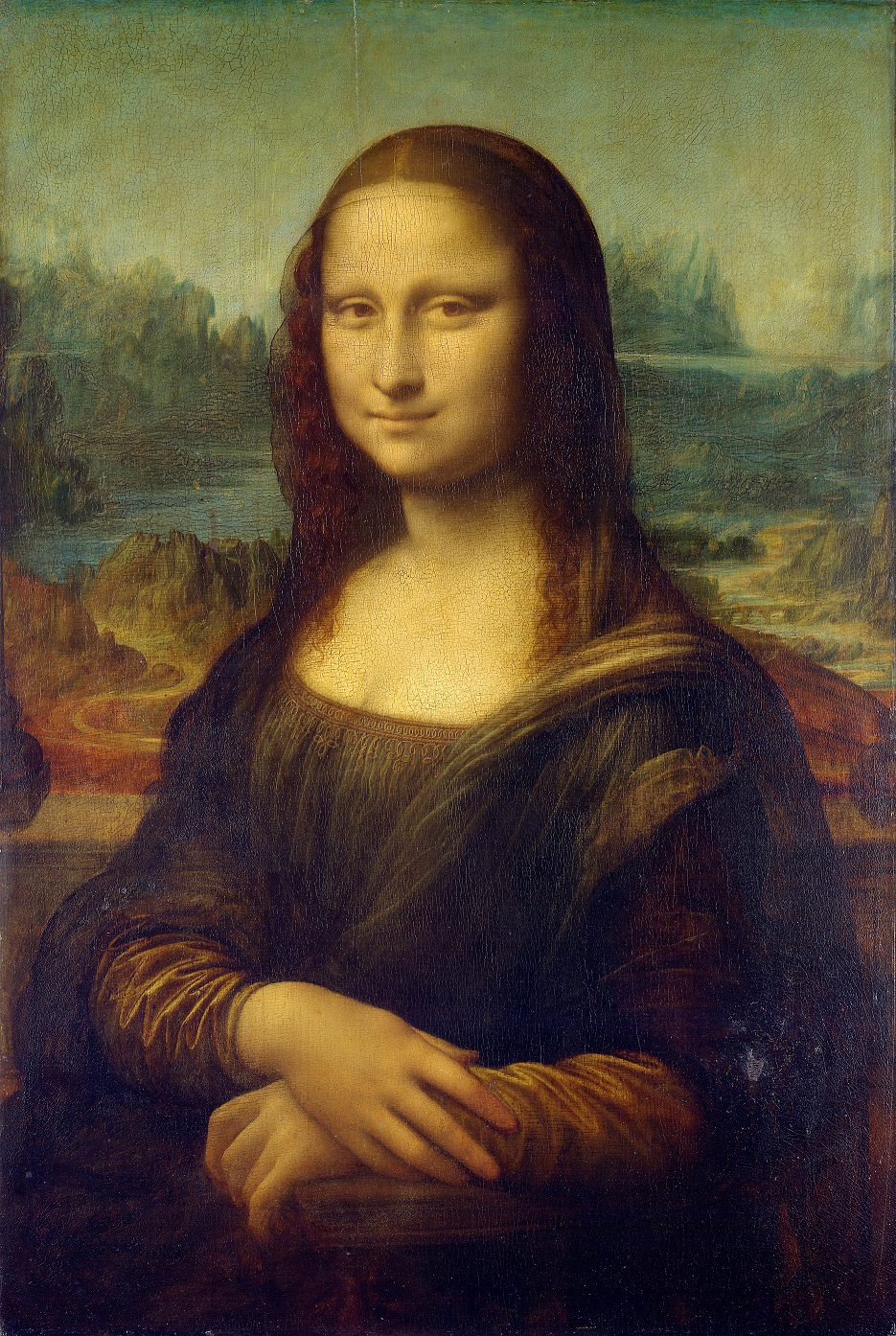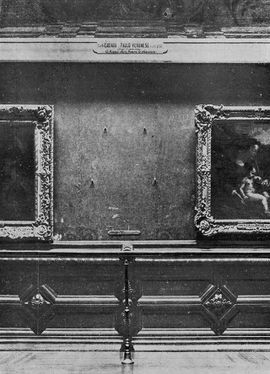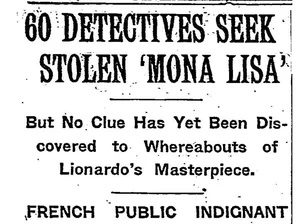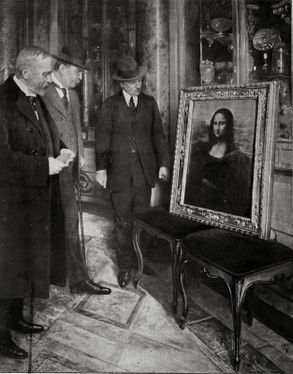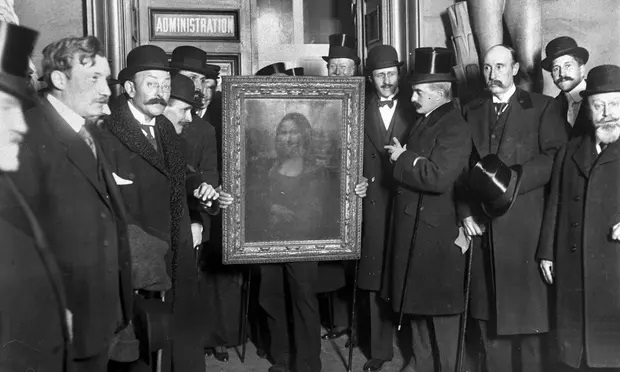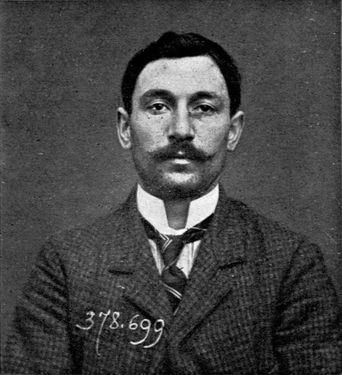Mona Lisa (found Leonardo da Vinci portrait painting; 1503-1506): Difference between revisions
(Amazingly, not a joke article. In fact, this incident means the Mona Lisa may well be the most famous case of lost media, ever. Lost for over two years (thus it meets our criteria!!), it almost ended up being a mainstay in Italy!) |
No edit summary |
||
| Line 7: | Line 7: | ||
|foundby=''Alfredo Geri and Giovanni Poggi'' | |foundby=''Alfredo Geri and Giovanni Poggi'' | ||
}} | }} | ||
On 21st | On August 21st, 1911, Leonardo da Vinci's Mona Lisa '''was stolen from the Louvre Museum'''. The culprit, Vincenzo Peruggia, had removed the painting from its frame and had managed to leave without attracting suspicion. It was not until November 1913 that the painting publicly resurfaced, after Peruggia attempted to sell it to the Uffizi Gallery in Florence, Italy. | ||
==Background== | ==Background== | ||
While the Mona Lisa is now one of the most famous paintings in the world, back in the early 1910s, it was not especially well-regarded by the general public and was only deemed a masterpiece by art critics.<ref name="npr">[https:// | While the Mona Lisa is now one of the most famous paintings in the world, back in the early 1910s, it was not especially well-regarded by the general public and was only deemed a masterpiece by art critics.<ref name="npr">[https://npr.org/2011/07/30/138800110/the-theft-that-made-the-mona-lisa-a-masterpiece?t=1651825663120 ''NPR'' detailing the Mona Lisa's theft and how it actually made the painting more famous.] Retrieved 26th May '22</ref><ref name="interesting">[https://allthatsinteresting.com/vincenzo-peruggia-mona-lisa-theft ''All That's Interesting'' detailing the theft.] Retrieved 26th May '22</ref> As historian James Zug notes, there were actually other paintings within the Salon Carré gallery in the Louvre that were more famous than it.<ref name="npr"/> During this time period, the painting and other Louvre works were to be photographed.<ref name="npr"/> But by the time the photographers were present at the Museum, nobody had realised the painting was stolen 28 hours previously.<ref name="npr"/><ref name="interesting"/> | ||
==The Theft== | ==The Theft== | ||
Vincenzo Peruggia was an Italian museum worker and artist that had previously been a Louvre employee. According to some sources, he was incensed that the Mona Lisa was being displayed in France, believing that it was stolen from Florence by Napoleon and that it should be returned there.<ref name="pbs">[https:// | Vincenzo Peruggia was an Italian museum worker and artist that had previously been a Louvre employee. According to some sources, he was incensed that the Mona Lisa was being displayed in France, believing that it was stolen from Florence by Napoleon and that it should be returned there.<ref name="pbs">[https://pbs.org/treasuresoftheworld/mona_lisa/mlevel_2/mlevel2_trial.html ''PBS'' detailing Peruggia's motivations and his trial.] Retrieved 26th May '22</ref><ref name="interesting"/> Thus, on 21st August 1911, Peruggia made plans to steal the painting, disguising himself as a Louvre employee by wearing a white smock.<ref name="interesting"/> At around 7 am, he entered the Museum via a staff door, and travelled to the Salon Carré which was devoid of people.<ref name="npr"/> He proceeded to remove the painting from its iron pegs, before taking off its protective case and frame.<ref name="npr"/> He then wrapped the smock around the painting, and quietly left the Louvre while tucking the painting under his arm.<ref name="interesting"/><ref name="npr"/> | ||
It is believed that Peruggia planned to quickly sell the painting. However, when it was finally discovered the Mona Lisa had been stolen, the theft made worldwide headlines, with ''The New York Times'' stating "60 Detectives Seek Stolen 'Mona Lisa'".<ref>[https:// | It is believed that Peruggia planned to quickly sell the painting. However, when it was finally discovered the Mona Lisa had been stolen, the theft made worldwide headlines, with ''The New York Times'' stating "60 Detectives Seek Stolen 'Mona Lisa'".<ref>[https://nytimes.com/1911/08/24/archives/60-detectives-seek-stolen-mona-lisa-but-no-clue-has-yet-been.html ''The New York Times''' original report on the Mona Lisa being stolen.] Retrieved 26th May '22</ref><ref name="npr"/><ref name="interesting"/> The painting's disappearance had actually resulted in the artwork becoming famous overnight, with many people entering the Louvre to witness the empty site that the Mona Lisa was once situated at.<ref name="interesting"/><ref name="npr"/> With significant media attention and numerous rewards offered, Peruggia was unable to flog the painting and decided to instead hide it in the false bottom of a trunk at his Paris boarding house.<ref name="interesting"/><ref name="npr"/> | ||
==Recovery== | ==Recovery== | ||
In November 1913, Peruggia was becoming desperate to sell the Mona Lisa, having taken it to an apartment in Florence.<ref name="npr"/> He made contact with Alfredo Geri, an arts dealer who was interested in buying it.<ref name="mukund">[https://mukundsathe.com/tag/giovanni-poggi/ ''Mukund Sathe'' detailing how the painting was recovered.] Retrieved 26th May '22</ref> Peruggia felt he was entitled to a reward for bringing to painting back to its "homeland".<ref name="ransom">[https:// | In November 1913, Peruggia was becoming desperate to sell the Mona Lisa, having taken it to an apartment in Florence.<ref name="npr"/> He made contact with Alfredo Geri, an arts dealer who was interested in buying it.<ref name="mukund">[https://mukundsathe.com/tag/giovanni-poggi/ ''Mukund Sathe'' detailing how the painting was recovered.] Retrieved 26th May '22</ref> Peruggia felt he was entitled to a reward for bringing to painting back to its "homeland".<ref name="ransom">[https://history.com/this-day-in-history/theft-of-mona-lisa-is-discovered ''History'' detailing Peruggia's ultimately unsuccessful attempt to sell the painting.] Retrieved 26th May '22</ref><ref name="interesting"/><ref name="npr"/> Nevertheless, a suspicious Geri contacted Giovanni Poggi, the director of the Uffizi Gallery, to authenticate the painting.<ref name="interesting"/><ref name="npr"/> Poggi affirmed that the painting was the stolen Mona Lisa after authenticating a stamp on the back of it.<ref name="npr"/> Geri and Poggi then informed Peruggia that they would store the painting for safekeeping.<ref name="mukund"/><ref name="interesting"/><ref name="npr"/> Not long afterwards, the police were contacted, and Peruggia was arrested.<ref name="interesting"/><ref name="mukund"/><ref name="ransom"/> | ||
Peruggia pleaded guilty to stealing the painting, with the court accepting that the theft was partly motivated via patriotism.<ref name="pbs"/><ref name="interesting"/> Thus, he was sentenced to a year and 15 days in prison, though he ultimately only served eight months.<ref name="pbs"/><ref name="interesting"/> The return of the Mona Lisa to Italy spread great joy in the country, with the painting briefly displayed at the Uffizi.<ref name="italy">[https://news.italy-museum.com/leonardo-da-vincis-mona-lisa/ ''Italy Museum'' detailing the painting being displayed at the Uffizi Gallery before being returned to the Louvre.] Retrieved 26th May '22</ref><ref name="npr"/> However, it was returned to the Louvre in January 1914.<ref name="history">[https:// | Peruggia pleaded guilty to stealing the painting, with the court accepting that the theft was partly motivated via patriotism.<ref name="pbs"/><ref name="interesting"/> Thus, he was sentenced to a year and 15 days in prison, though he ultimately only served eight months.<ref name="pbs"/><ref name="interesting"/> The return of the Mona Lisa to Italy spread great joy in the country, with the painting briefly displayed at the Uffizi.<ref name="italy">[https://news.italy-museum.com/leonardo-da-vincis-mona-lisa/ ''Italy Museum'' detailing the painting being displayed at the Uffizi Gallery before being returned to the Louvre.] Retrieved 26th May '22</ref><ref name="npr"/> However, it was returned to the Louvre in January 1914.<ref name="history">[https://history.com/this-day-in-history/mona-lisa-recovered-in-florence ''History'' summarising the theft and the painting's glass enclosure.] Retrieved 26th May '22</ref><ref name="interesting"/><ref name="npr"/> Since then, another theft of the Mona Lisa is extremely unlikely to occur. In addition to the Louvre's security systems, the painting is protected by a glass enclosure that is strong enough to withstand various vandalism attempts over the years.<ref>[https://reuters.com/article/us-france-mona-lisa-idUSKBN1WN1T3 ''Reuters'' reporting on the Mona Lisa's new protective glass.] Retrieved 26th May '22</ref><ref name="history"/><ref name="ransom"/> | ||
==Gallery== | ==Gallery== | ||
Latest revision as of 16:32, 14 August 2022
On August 21st, 1911, Leonardo da Vinci's Mona Lisa was stolen from the Louvre Museum. The culprit, Vincenzo Peruggia, had removed the painting from its frame and had managed to leave without attracting suspicion. It was not until November 1913 that the painting publicly resurfaced, after Peruggia attempted to sell it to the Uffizi Gallery in Florence, Italy.
Background
While the Mona Lisa is now one of the most famous paintings in the world, back in the early 1910s, it was not especially well-regarded by the general public and was only deemed a masterpiece by art critics.[1][2] As historian James Zug notes, there were actually other paintings within the Salon Carré gallery in the Louvre that were more famous than it.[1] During this time period, the painting and other Louvre works were to be photographed.[1] But by the time the photographers were present at the Museum, nobody had realised the painting was stolen 28 hours previously.[1][2]
The Theft
Vincenzo Peruggia was an Italian museum worker and artist that had previously been a Louvre employee. According to some sources, he was incensed that the Mona Lisa was being displayed in France, believing that it was stolen from Florence by Napoleon and that it should be returned there.[3][2] Thus, on 21st August 1911, Peruggia made plans to steal the painting, disguising himself as a Louvre employee by wearing a white smock.[2] At around 7 am, he entered the Museum via a staff door, and travelled to the Salon Carré which was devoid of people.[1] He proceeded to remove the painting from its iron pegs, before taking off its protective case and frame.[1] He then wrapped the smock around the painting, and quietly left the Louvre while tucking the painting under his arm.[2][1]
It is believed that Peruggia planned to quickly sell the painting. However, when it was finally discovered the Mona Lisa had been stolen, the theft made worldwide headlines, with The New York Times stating "60 Detectives Seek Stolen 'Mona Lisa'".[4][1][2] The painting's disappearance had actually resulted in the artwork becoming famous overnight, with many people entering the Louvre to witness the empty site that the Mona Lisa was once situated at.[2][1] With significant media attention and numerous rewards offered, Peruggia was unable to flog the painting and decided to instead hide it in the false bottom of a trunk at his Paris boarding house.[2][1]
Recovery
In November 1913, Peruggia was becoming desperate to sell the Mona Lisa, having taken it to an apartment in Florence.[1] He made contact with Alfredo Geri, an arts dealer who was interested in buying it.[5] Peruggia felt he was entitled to a reward for bringing to painting back to its "homeland".[6][2][1] Nevertheless, a suspicious Geri contacted Giovanni Poggi, the director of the Uffizi Gallery, to authenticate the painting.[2][1] Poggi affirmed that the painting was the stolen Mona Lisa after authenticating a stamp on the back of it.[1] Geri and Poggi then informed Peruggia that they would store the painting for safekeeping.[5][2][1] Not long afterwards, the police were contacted, and Peruggia was arrested.[2][5][6]
Peruggia pleaded guilty to stealing the painting, with the court accepting that the theft was partly motivated via patriotism.[3][2] Thus, he was sentenced to a year and 15 days in prison, though he ultimately only served eight months.[3][2] The return of the Mona Lisa to Italy spread great joy in the country, with the painting briefly displayed at the Uffizi.[7][1] However, it was returned to the Louvre in January 1914.[8][2][1] Since then, another theft of the Mona Lisa is extremely unlikely to occur. In addition to the Louvre's security systems, the painting is protected by a glass enclosure that is strong enough to withstand various vandalism attempts over the years.[9][8][6]
Gallery
Video
Images
References
- ↑ 1.00 1.01 1.02 1.03 1.04 1.05 1.06 1.07 1.08 1.09 1.10 1.11 1.12 1.13 1.14 1.15 1.16 NPR detailing the Mona Lisa's theft and how it actually made the painting more famous. Retrieved 26th May '22
- ↑ 2.00 2.01 2.02 2.03 2.04 2.05 2.06 2.07 2.08 2.09 2.10 2.11 2.12 2.13 2.14 All That's Interesting detailing the theft. Retrieved 26th May '22
- ↑ 3.0 3.1 3.2 PBS detailing Peruggia's motivations and his trial. Retrieved 26th May '22
- ↑ The New York Times' original report on the Mona Lisa being stolen. Retrieved 26th May '22
- ↑ 5.0 5.1 5.2 Mukund Sathe detailing how the painting was recovered. Retrieved 26th May '22
- ↑ 6.0 6.1 6.2 History detailing Peruggia's ultimately unsuccessful attempt to sell the painting. Retrieved 26th May '22
- ↑ Italy Museum detailing the painting being displayed at the Uffizi Gallery before being returned to the Louvre. Retrieved 26th May '22
- ↑ 8.0 8.1 History summarising the theft and the painting's glass enclosure. Retrieved 26th May '22
- ↑ Reuters reporting on the Mona Lisa's new protective glass. Retrieved 26th May '22
